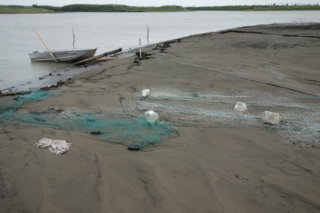In August, I had the opportunity to participate in a workshop titled “Solid Fluids. New Approaches to Materials and Meaning” at the University of Aberdeen, Scotland. Organised by the anthropologists Cris Simonetti and Tim Ingold, it drew together 15 researchers from likeminded fields (including, alongside anthropology, geography, sociology, archaeology, design and art) to discuss empirical cases where people encountered fluids that were also solid, or solids that were also fluid, how they made sense of these materials, and how these insights may help understand the world not in binaries of solid against fluid, particle against wave, mind against matter, but as something more integrated.
Cris and Tim had been thinking about this tension of solid versus fluid for some time already, as part their project called Solid Fluids in the Anthropocene, and had recently published a short article titled Ice and Concrete: Solid Fluids of Environmental Change in the Journal of Contemporary Archaeology. Here, they review the scientific treatment of two solid fluids – ice and concrete – and observe that fluidity and solidity continue to be presented as opposed qualities. Cris and Tim, instead, suggest starting “with an ontology in which fluidity and solidity are not mutually incompatible properties” (p.28).
At the workshop, we learned how multidimensional the issue of “solid fluids” is, even for the humanities and social sciences. It has structured scientific debates, for instance in glaciology, on whether glaciers behave like solids or fluids, and similarly, in soil science, on whether soil processes are mechanic or fluid. Solid fluids matter in the mobile dynamics within archaeological strata and other human-made soils, including landfills; they relate to earthquakes and the ways in which architecture attempt to address them; and they speak to questions of heat in magma, kilns and manufactured objects. Approaching research topics as solid fluids evidently also changes the things we may find out about them, such as understanding the art of glass-making as the solidification of light; or studying the commodification of sea waves for electricity generation. Moreover, our occasional forays into physics yielded a few through-provoking insights for the physical amateurs, including that there is a whole class of matter called “non-Newtonian fluids” – like ketchup and silly putty – that behave like solids under some circumstances and like fluids in others.
In my own contribution, based on my recent experiences with ice, permafrost, water and mud in the Mackenzie Delta, I was eager to demonstrate that even though we can productively speak materials and meaning as solid fluids, it is very often crucially important whether a phenomenon is actually rather solid or rather fluid in a particular situation. While the solid fluids perspective emphasises that materials and meanings are always at the same time both, solid and fluid, it matters a lot for life in the Mackenzie Delta whether the ground is frozen solid or liquid mud, whether rivers and lakes are covered in ice or open water, and whether the snow is dry or slushy.
I noted that current manifestations of climate change, including uncertain ice conditions and permafrost erosion, are only among the most recent set of transformations in the delta. Its inhabitants have had to negotiate colonial rule, different boom and bust economies, and the de- and re-valuation of indigenous identity, among other radical changes. While transformations are evidently part of people’s lives, this does not make the distinction between solidity and fluidity arbitrary. Rather, the concerns and strategies of delta inhabitants suggest that fluidity and solidity remain important attributes. They are significant not as exclusive properties, however, but as relational qualities, in the context of particular human projects and activities.
I outlined some of the mobility practices of current Mackenzie Delta inhabitants – e.g. ice road construction and use, snowmobile journeys, and boating trips – and discussed them in relation to the solid fluids in the delta, including permafrost, ice/water and gravel.
For example during the winter, when deep snow weighs down the ice of river and lakes and pushes water on top, a phenomenon called “overflow” may develop. The water pushed on top of the ice usually seeps into the snow and creates a treacherous slush, not visible from the snow surface, which can stall snowmobiles. Once trapped in the overflow, travellers can only get out with a lot of effort, and usually soaked snow pants. On my winter trips through the Mackenzie Delta, I got stuck with a snowmobile many times, one of which in the infamous overflow in a long and narrow channel that is known for developing this phenomenon. After my companions had helped me to drive out from the slush and back onto dry snow, and as our boots and snow pants were drying next to a wood stove in a cabin, they explained to me what they had already indicated with a few short shouts during the event. The only way to drive through overflow was to go as fast as possible, “skipping” across it, as they call it. This is the same word that they use for driving a snowmobile across open water in the spring, when the snowmelt overflows and decays the ice on the edges of rivers and lakes, while it is still safe to drive along their centre. When we returned along the same river channel later that night, I was thus prepared to speed through the slush, which worked well. The next time I drove through this stretch was almost a month later, and the slush had frozen solid from all the snowmobile traffic that had passed by since, which made for an extremely bumpy trail.
This illustrates that not only is the materiality of the water/snow/ice relative to contextual dynamics like temperature and the weigh of fresh snow and the frequency of use of a snowmobile trail. But also, the affordance of this material differs with the speed by which someone confronts it. The question of solid fluids thereby becomes an issue of relative tempo, or interlocking and conflicting rhythms.
Based on these discussions, I proposed that Henri Lefebvre’s notion of “tempo” may help to illustrate the predicament of living in a world that is solid and fluid in relation to particular practices. Lefebvre, in his famous essays on rhythmanalysis, had pointed out that tempo is always relative – something can be slow of fast only in relation to something else. For the discussion of solid fluids, this means that solidity and fluidity – whether things appear hard or liquid – is equally a question of a relation to something else, where this something else is the body and activities of the perceiver or practitioner. Lefebvre famously declared that for an aspiring rhythmanalyst,
“nothing is immobile. He hears the wind, the rain, storms; but if he considers a stone, a wall, a trunk, he understands their slowness, their interminable rhythm. This object is not inert; time is not set aside for the subject. It is only slow in relation to our time, to our body, the measure of rhythms” (p. 20).
Rhythms and their tempos are thus always relative to those of our bodies, and – we may add – to the things we do with our bodies. Lefebvre made this point in order to demystify apparent solidity as actual ‘slowness’, but we can respectively use the same tool to understand fluidity as ‘fastness’.
To sum up, economic cycles, political climate, sociocultural dynamics and physical transformations can all be experienced as both solid and fluid, depending on the degree to which they resonate with what people seek to do or explain. Yes, solid fluids abound once we pay attention to the way that even ostensibly solid things are inherently fluid, and obvious fluids may appear solid. Water is a case in point: it can be fluid for someone swimming in it; solid for someone jumping into it from too high; and sticky – something in between solid and fluid – for an insect touching its surface (thanks to Bron Szerszynski for mentioning this third relation during the workshop). This also brings home the message from the Mackenzie Delta fieldwork, however: things are not just solid fluids in themselves, but emerge as solid and fluid in relation to specific endeavours and processes, like riding a snowmobile. Tempo may be a good term to think about how solid fluids matter, and how it remains significant to what extent they are relatively solid or fluid for particular activities.
In a world where everything seems to be changed and changing, solidity and fluidity may best be seen as indications of gradual differences in tempo.

